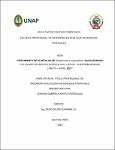Crecimiento de plántulas de Campsiandra angustifolia "huacapurana" utilizando diferentes dosis de NPK, CIEFOR - Puerto Almendra, Loreto - Perú, 2021
Abstract
The study was carried out in Parcel No. 12 in Ciefor - Puerto Almendras, evaluating 200 Campsiandra angustifolia plants, planted every 5 meters and in 10 strips. The greatest increase in diameter was presented by treatment B (20% NPK dose) with a value of 0,58 mm between the first and last evaluation. There is a difference between the averages of the increase in diameter of the plants, where treatment E (80% of NPK dose) presents the highest average with 86,89 mm. The greatest increase in height was presented by treatment B with a value of 45,28 cm. The results of the nonparametric Kruskal Wallis test for the comparison of height increase and the treatments indicate that there is a difference between the averages, the treatment B showing the highest value with 93,27 cm. A total of 149 live Campsiandra angustifolia "huacapurana" plants were found, representing 83.5% of the total; while it had a mortality of 33 plants (16.5%). At a general level in the experiment, the Bueno quality (Treatment B, C, D and E) was recorded for the Campsiandra angustifolia seedlings at the end of the study. El estudio se realizó en la Parcela Nº 12 del Ciefor – Puerto Almendras, evaluándose 200 plantas de Campsiandra angustifolia. El mayor incremento en diámetro lo presentó el tratamiento B (20% de dosis de NPK) con un valor de 0,58 cm entre la primera y última evaluación. Existe diferencia entre los promedios del incremento en diámetro de las plantas, donde el tratamiento B presenta el mayor promedio con 86,89 cm. El mayor incremento en altura lo presentó el tratamiento B con un valor de 45,28 cm. Los resultados de la prueba no paramétrica de Kruskal Wallis para la comparación de incremento de altura y los tratamientos indican que existe diferencia entre los promedios, mostrando el tratamiento B el mayor valor con 93,27 cm. Se encontró un total de 149 plantas vivas de Campsiandra angustifolia “huacapurana” que representa el 83,5% del total; mientras que tuvo una mortalidad de 33 plantas (16,5%). A nivel general en el experimento se registró la calidad Buena (Tratamientos B, C, D y E) para las plántulas de Campsiandra angustifolia al final del estudio.
Collections
- Tesis [400]


